Like a hidden gem waiting to be discovered, the Lakeland Terrier possesses a charm and character that is as intriguing as it is captivating. From its origins in the picturesque Lake District of England to its lively and spirited nature, this breed offers a delightful combination of qualities that make it truly unique.
But what exactly sets the Lakeland Terrier apart from other dog breeds? What are its defining characteristics and how does it fit into different lifestyles? Prepare to be enthralled as we unravel the fascinating world of the Lakeland Terrier, uncovering its history, temperament, and adaptability, providing you with a deeper understanding of this remarkable breed.
Key Takeaways
- Lakeland Terriers are small, bold, and friendly dogs with a curious and intelligent personality.
- They are excellent watchdogs and have a strong instinct to protect their family.
- Lakeland Terriers are generally a healthy breed, but potential health conditions to be aware of include hip dysplasia, patellar luxation, progressive retinal atrophy (PRA), and Legg-Calvé-Perthes Disease.
- They require daily exercise, a securely fenced yard, and positive reinforcement training techniques.
Origin and Size
The Lakeland Terrier originated in the county of Cumberland in England's Lake District, where it was bred to protect sheep from the Westmoreland fox. This small breed typically stands between 13 to 15 inches tall and weighs around 15 to 20 pounds. They belong to the terrier group and have a wiry and harsh coat.
In addition to their role as sheep protectors, Lakeland Terriers were also used for various sports such as badger digging, rabbiting, ratting, and fox hunting. They're classified as colored working terriers and have a strong connection to other terrier breeds like the Old English Black and Tan Terrier, Dandie Dinmont and Bedlington Terriers, and Border Terrier.
Breed Group and Lifespan
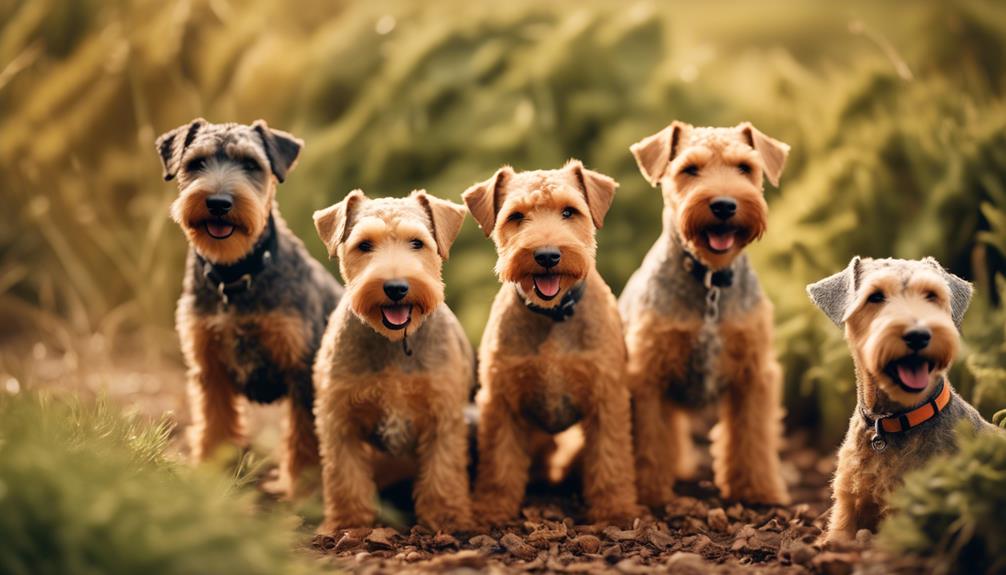
After discussing the origin and size of the Lakeland Terrier, it's important to explore their breed group and lifespan.
- The Lakeland Terrier belongs to the Terrier breed group, which is known for their feisty and energetic nature.
- As for their lifespan, Lakeland Terriers typically live for about 12 to 15 years, which is relatively long compared to other dog breeds.
- This breed's longevity can be attributed to their overall good health and minimal hereditary health problems.
- Proper care, regular exercise, and a balanced diet can also contribute to their extended lifespan.
Coat and History

Lakeland Terriers have a distinctive coat and an intriguing history. Their coat is wiry and harsh, providing protection from the elements. It consists of a thick, hard topcoat and a soft undercoat. The coat comes in various colors including blue, black, liver, red, and wheaten, with some having a tan saddle covering the back. In shows, the coat is hand stripped to maintain a neat appearance.
As for their history, Lakeland Terriers originated in the county of Cumberland in England's Lake District. They were bred to protect sheep from the Westmoreland fox and were used for various sports such as badger digging, rabbiting, ratting, and fox hunting. They're classified as colored working terriers and are related to the Old English Black and Tan Terrier, Dandie Dinmont and Bedlington Terriers, and Border Terrier.
Related Breeds
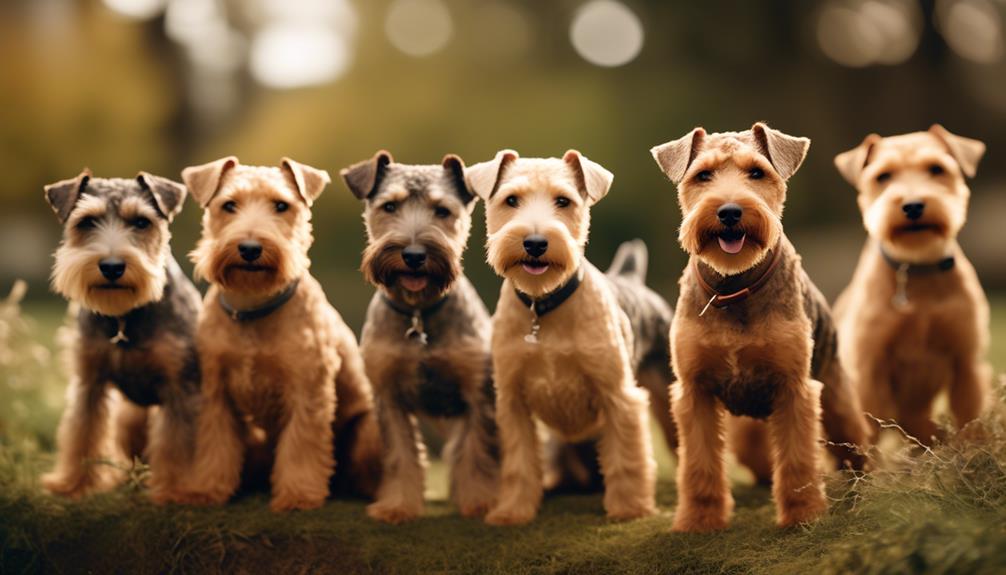
The Lakeland Terrier is closely related to other terrier breeds such as the Old English Black and Tan Terrier, Dandie Dinmont and Bedlington Terriers, and the Border Terrier. These breeds share similar characteristics and traits, including their small size, wiry and harsh coat, and lively temperament.
Here are four key points about the related breeds:
- Old English Black and Tan Terrier: This breed was a predecessor to the Lakeland Terrier and played a role in its development. It's known for its distinctive black and tan coat.
- Dandie Dinmont Terrier: This terrier breed is known for its unique body shape and large, expressive eyes. It has a soft and silky coat and is highly adaptable and friendly.
- Bedlington Terrier: This breed is recognized for its curly, woolly coat and lamb-like appearance. It's intelligent, energetic, and makes a great companion for active individuals or families.
- Border Terrier: This terrier breed shares a similar size and temperament with the Lakeland Terrier. It's known for its affectionate and loyal nature, making it a popular choice for families.
Personality Traits
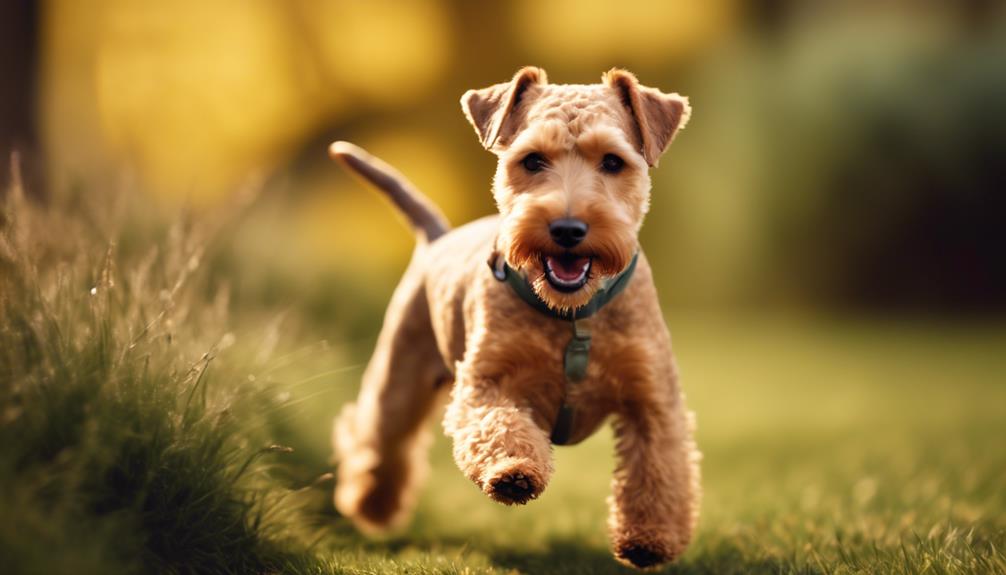
Bold and friendly, the Lakeland Terrier is known for its curious, intelligent, and entertaining personality. This breed is always up for an adventure and loves exploring its surroundings.
Lakeland Terriers are highly alert and self-confident, making them excellent watchdogs. While they can be reserved with strangers, they're incredibly affectionate towards their family, especially children. Their playful nature and high energy levels make them great companions for kids.
Lakeland Terriers have a strong instinct to protect their loved ones and won't back down from a fight if necessary. However, they generally get along well with other dogs if properly introduced.
With their charm and lively temperament, the Lakeland Terrier is sure to bring joy and laughter to any household.
Health Considerations
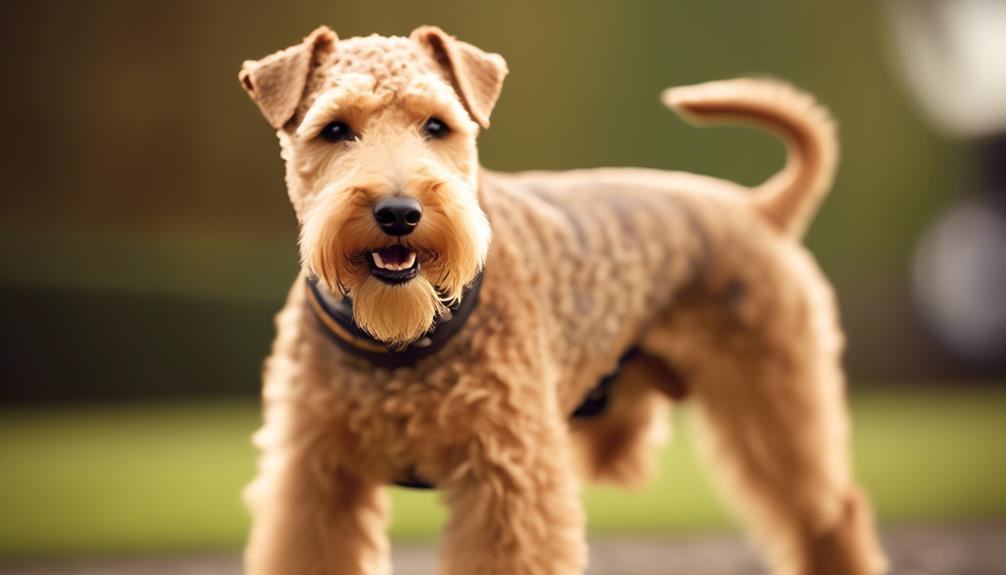
When considering the health of the Lakeland Terrier, it's important to be aware of certain conditions that may affect the breed. These health considerations include:
- Hip Dysplasia: This is a common condition in which the hip joint doesn't develop properly, leading to pain and mobility issues.
- Patellar Luxation: This occurs when the kneecap slips out of place, causing lameness and discomfort.
- Progressive Retinal Atrophy (PRA): This is a degenerative eye disease that can lead to vision loss and blindness.
- Legg-Calvé-Perthes Disease: This is a condition in which the blood supply to the head of the femur bone is disrupted, causing the bone to deteriorate and leading to pain and limping.
Care and Training
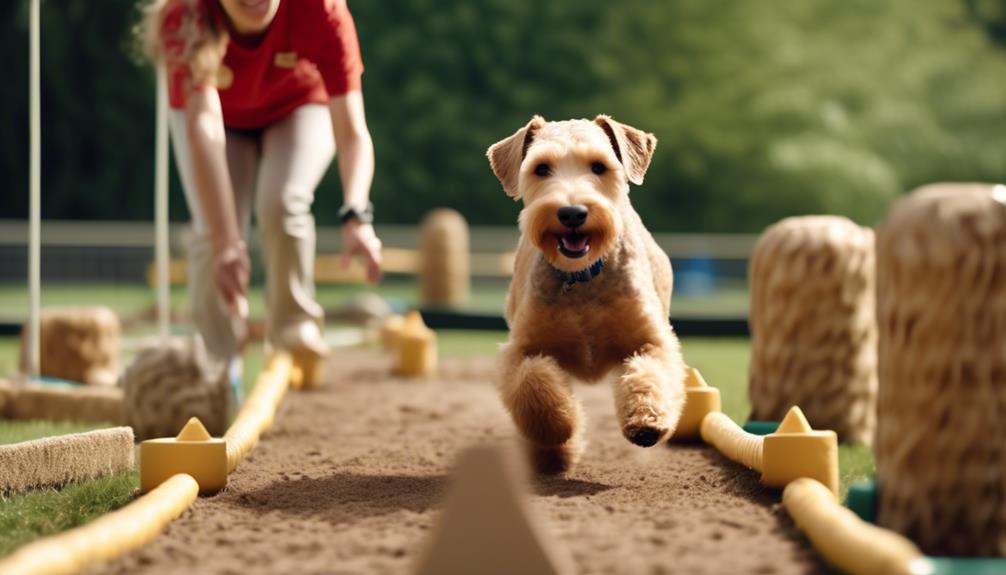
After considering the health considerations for the Lakeland Terrier, it's essential to understand the care and training needed for this breed.
Lakeland Terriers should live indoors with their owners and are suitable for apartment life if trained not to bark excessively. They require daily walks and playtime to stay active. Due to their nature as diggers and escape artists, they need a securely fenced yard.
Training a Lakeland Terrier can be a challenge, but positive reinforcement techniques work best. It's important to measure their food intake and feed them twice a day to maintain a good shape.
Grooming-wise, their wiry and harsh coat should be hand stripped for a neat appearance.
Diet and Feeding

Lakeland Terriers require a balanced and nutritious diet to maintain their health and well-being. Here are some important points to consider when it comes to the diet and feeding of Lakeland Terriers:
- Food intake: The amount of food a Lakeland Terrier needs depends on factors such as size, age, build, metabolism, and activity level. Highly active dogs may require more food than sedentary dogs.
- Quality of dog food: The quality of the dog food plays a significant role in providing the necessary nourishment. Choosing a high-quality dog food ensures that your Lakeland Terrier receives the right nutrients.
- Meal frequency: It's recommended to measure the food and feed your Lakeland Terrier twice a day. This helps in maintaining their good shape and prevents overeating.
- Monitoring weight: Conducting a hands-on test can help determine if your Lakeland Terrier is overweight. Regularly monitoring their weight is important for their overall health and well-being.
Coat Color and Grooming
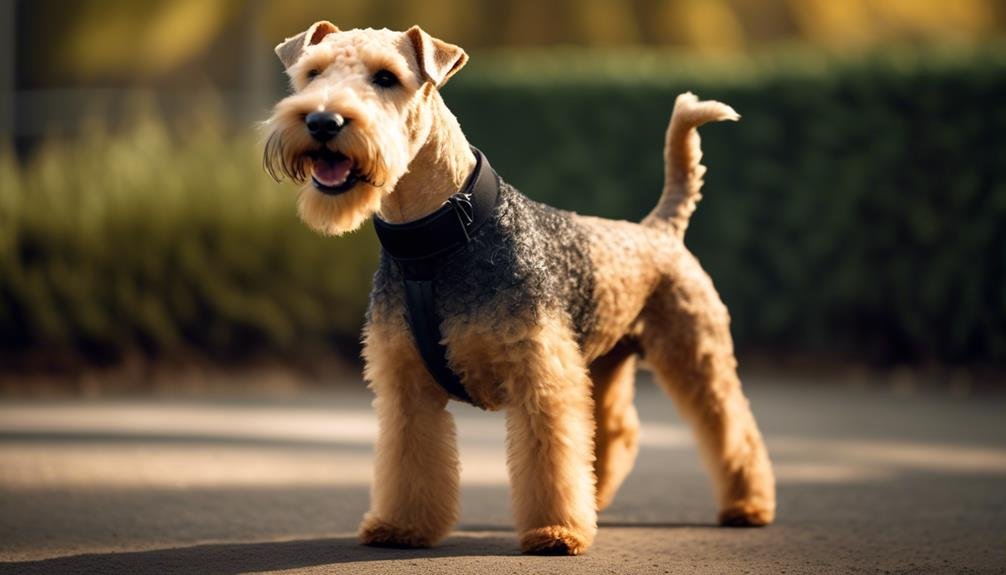
The coat color and grooming of Lakeland Terriers play an important role in their overall appearance and maintenance.
Lakeland Terriers have a thick, wiry, and harsh coat that requires regular care to keep it looking neat and healthy.
Their coats come in a variety of colors including blue, black, liver, red, and wheaten. Some Lakeland Terriers may have a tan saddle covering their back.
To maintain their coat, hand stripping is recommended for a neat appearance in shows. Stripping or clipping the coat can affect the texture and color.
Regular grooming also includes brushing their coat to remove any tangles or mats.
Additionally, their ears should be checked and cleaned regularly to prevent any infections.
With proper grooming, Lakeland Terriers can maintain their distinctive appearance and stay healthy.
Interactions With Children and Other Pets
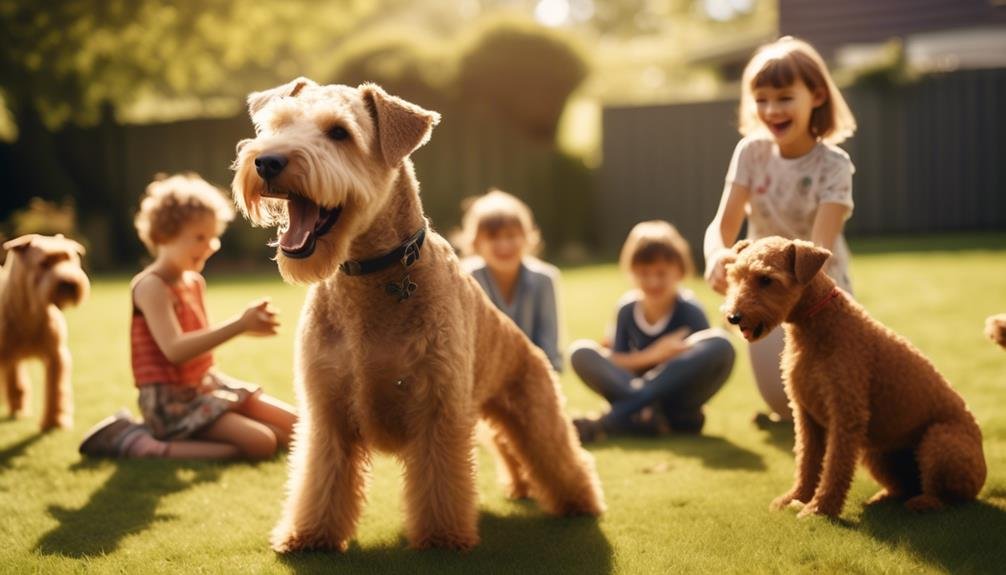
Moving on from discussing the coat color and grooming of Lakeland Terriers, it's important to understand their interactions with children and other pets. Here are a few key points to consider:
- Lakeland Terriers love kids but interactions should always be supervised. It's crucial to teach children the proper approach and interaction with dogs, including not approaching them while they're sleeping or eating.
- Lakelands can get along well with other pets if they're introduced early and properly socialized. However, caution should be exercised with outdoor cats and small pocket pets due to the terrier's natural prey drive.
- Training and socialization play a significant role in shaping the Lakeland Terrier's behavior towards children and other pets. Positive reinforcement techniques are recommended to ensure they develop appropriate and friendly interactions.
- While Lakeland Terriers have a friendly and lively temperament, their self-confidence and alertness make them excellent watchdogs. They may not start fights with other dogs but are unlikely to back down from one, making it important to monitor their interactions with unfamiliar dogs.
Adaptability to Apartment Living

Living in an apartment can be a suitable environment for Lakeland Terriers due to their adaptability and small size. These terriers are known for their ability to adapt to different living situations, making them well-suited for apartment living. They're small in size, typically measuring 13-15 inches tall and weighing 15-20 pounds, which makes them easily manageable in smaller living spaces.
However, it's important to train them not to bark excessively to ensure a harmonious living environment for all residents. Lakeland Terriers still require daily walks and playtime to meet their exercise needs, but their adaptability and low-energy nature make them well-suited for apartment living.
With proper training and care, Lakeland Terriers can thrive and be happy in an apartment setting.
Factors to Consider for Apartment Living

When considering apartment living with a Lakeland Terrier, it's important to take into account various factors that can contribute to a harmonious living environment. Here are four factors to consider:
- Size and Energy Level: Lakeland Terriers are small in size and have moderate energy levels. They can adapt well to apartment living as long as they receive daily exercise and mental stimulation.
- Barking Tendency: Some Lakeland Terriers may have a tendency to bark. It's important to train them not to bark excessively to maintain a peaceful living environment in an apartment building.
- Socialization: Lakeland Terriers should be properly socialized from a young age to ensure they get along well with other dogs and people in shared living spaces.
- Training: These terriers can be independent and challenging to train. Consistent and positive reinforcement techniques should be used to establish good behavior and obedience.
All-around Friendliness
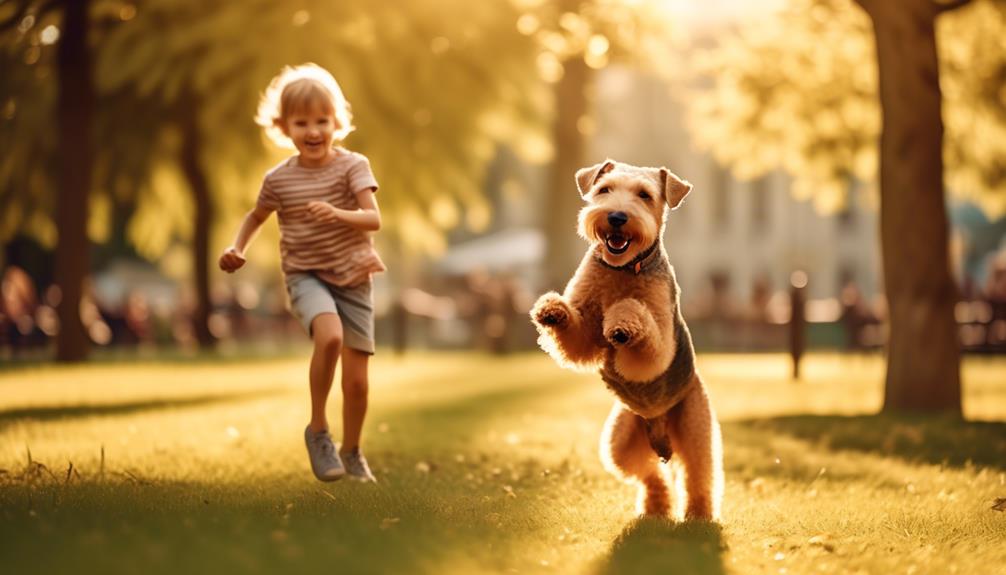
Taking into account the factors for apartment living, the Lakeland Terrier's all-around friendliness makes them a great companion for urban dwellers. These dogs are known to be affectionate with their family and are easy to train, making them an ideal choice for those living in close quarters.
Additionally, Lakeland Terriers are generally healthy, although they may be prone to some health problems. In terms of exercise needs, they've moderately high energy levels, requiring daily walks and playtime.
With their friendly, lively, and independent temperament, Lakeland Terriers can bring joy and entertainment to their owners in an apartment setting.
Overall, their all-around friendliness and adaptability make them a wonderful choice for apartment living.
Behavioral Traits
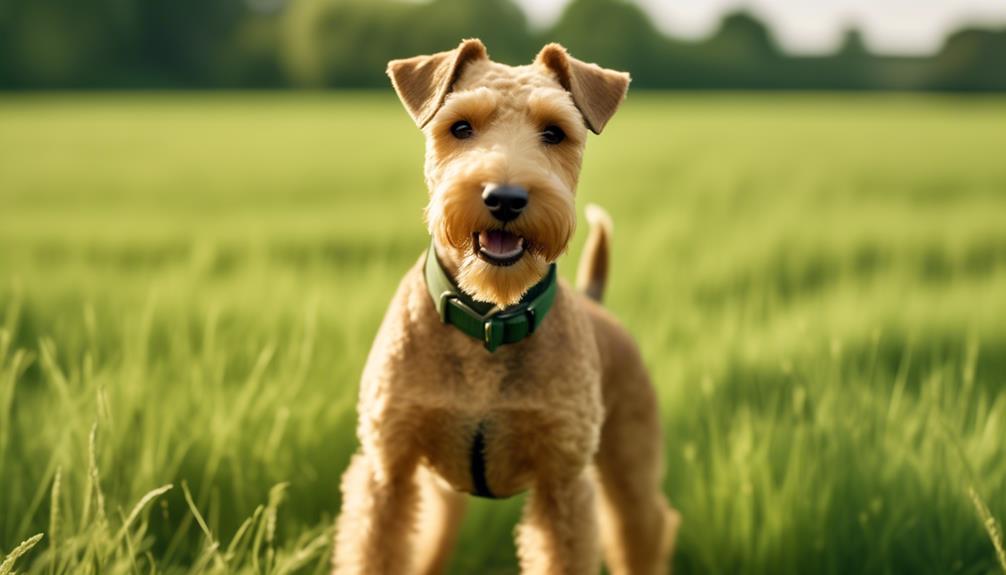
Lakeland Terriers exhibit various behavioral traits that can greatly impact their interactions with humans and other animals. These traits include fearlessness, independence, alertness, and terrier tendencies.
- Fearlessness: Lakeland Terriers are known for their bold and courageous nature. They aren't easily intimidated and will stand their ground when faced with a challenge.
- Independence: These terriers have an independent streak and may not always be eager to please. They're intelligent and have a mind of their own, which can make training a bit more challenging.
- Alertness: Lakeland Terriers are always on high alert. They make excellent watchdogs and will bark to alert their owners of any potential threats or intruders.
- Terrier Tendencies: As a terrier breed, Lakelands have a natural instinct to dig and hunt. They may exhibit behaviors such as digging in the yard or chasing small animals. Proper training and socialization from an early age can help manage these tendencies.
Frequently Asked Questions
Are Lakeland Terriers Good With Cats and Small Pocket Pets?
Lakeland Terriers can get along with other pets if introduced early, but caution should be exercised with outdoor cats and small pocket pets. Supervised interactions and proper training are essential.
How Often Should I Feed My Lakeland Terrier?
They should feed their Lakeland Terrier twice a day, using a high-quality dog food. The amount of food will depend on the size, age, metabolism, and activity level of the dog. It's important to measure the food to maintain a healthy weight.
Can Lakeland Terriers Be Left Alone for Long Periods of Time?
Lakeland Terriers should not be left alone for long periods of time. They thrive on human companionship and may become anxious or destructive if left alone for extended periods. They require regular social interaction and mental stimulation.
Do Lakeland Terriers Have a Strong Prey Drive?
Yes, Lakeland Terriers have a strong prey drive. They may pursue wild animals while on the hunt, putting themselves at risk. It is important to be cautious and provide proper training and supervision.
What Is the Average Lifespan of a Lakeland Terrier?
The average lifespan of a Lakeland Terrier is 12-15 years. They are generally healthy with no known hereditary health problems, but owners should be aware of conditions such as hip dysplasia and progressive retinal atrophy.
What are the similarities and differences between the Lakeland Terrier and the Kerry Blue Terrier?
The Kerry Blue Terrier and the Lakeland Terrier share similarities in their medium-size, wiry and waterproof coats, but they have differences in their coat color and temperament. The Kerry Blue Terrier breed information highlights its unique blue-gray coat, while the Lakeland Terrier is known for its variety of coat colors.
Conclusion
In conclusion, the Lakeland Terrier is a small-sized breed with a bold and friendly personality. Originating from England, they were bred to protect sheep from foxes. With their wiry coat and intelligence, they make excellent watchdogs.
While reserved with strangers, they're extremely affectionate towards their family, especially children. Their adaptability to apartment living depends on their exercise needs being met.
Overall, the Lakeland Terrier is a versatile and entertaining breed that can bring joy to any family or living situation.




